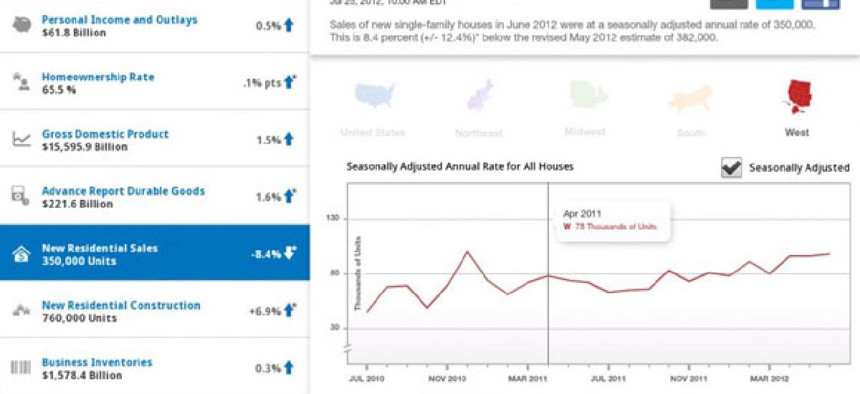Census debuts new economic indicator app

Gives the raw numbers for each piece of data as well as a graph charting a two-year trend line covering indicators.
Traders, policymakers, journalists, and economic-data junkies can now get information on 16 economic indicators from a mobile app released by the Census Bureau on Thursday for Android devices. An Apple iOS version is awaiting approval by the App Store.
The America’s Economy App, the first from the bureau, gives the raw numbers for each piece of data as well as a graph charting a two-year trend line covering employment, homeownership and housing vacancies, wholesale trade, manufacturing inventories, and other information. More-detailed historical data can be found on the bureau's website. The app also includes a schedule for the release of economic data. It also allows users to set alerts to have newly published information pushed out to their devices.
Appropriately, Census Bureau officials chose the “lockup” room in the Commerce Department to demo the new app. Lockup rooms are used by both the Commerce and Labor departments for releases of market-sensitive economic data, such as gross domestic product numbers and the monthly jobs figures. Journalists are sequestered incommunicado with privileged access to the government's reports for a half hour to an hour to write news stories for publication once the information is released to the public.
There was a rare bit commotion in the lockup room on Thursday, when reporters noted that the Labor Department had published information on jobless claims on its website 15 minutes before it was due to be released.
As a tool for reaching the public directly, the app can be seen as a direct competitor with the mainstream news services that race to produce advance stories in the lockup room. A consumer of data would probably find raw information faster on the app than on a news website, said Stephen Buckner, the director of the Center for New Media and Promotions at the Census Bureau. At the same time, the move doesn’t threaten the early press access to the data. From a security point of view, said William Bostic, chief of the Service Sector Statistics Division, the data that are published to the app and to websites are transmitted in such a way that they are not susceptible to early release.
Census is in the midst of expanding its public technological profile. In July, the agency released a set of APIs (application programming interfaces) that allow developers to pull information directly from the 2010 census and the American Community Survey. Developers can build web and mobile tools that mash up population and demographics in different ways. One early consumer is the real-estate site Zillow. Buckner said that the bureau's computers tallied 10 million data calls from sites just over the past weekend.
Congressional staffers are likely to be avid users of the app. If a member wants information on, say, unemployment claims going back 18 months while in the middle of a hearing, an aide can dig it up in with a few taps on a tablet or smartphone. But users will have to have Android or Apple devices – there are no current plans to create versions for Windows phones or BlackBerrys.
NEXT STORY: Confessions of a PowerPoint convert






